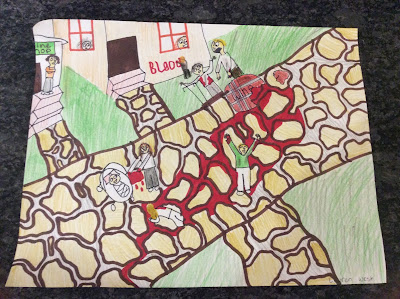Period 4
11/18/15
Charles Darnay analysis
 | |
| Charles Darnay pictures with quotes of Selflessness, Passion, and Bravery. These qualities are also symbolized by money, a ring, and a sword. |
Charles Darnay has displayed traits of bravery, selflessness, and passion within book two of the classic story A Tale of Two Cities by Charles Dickens. Darnay has proven to be a mysterious character, as we haven't learned too much about him so far, however Dickens has hinted that Darnay may become a crucial aspect of the story line. We first meet Darnay in a courtroom as he is on trial for treason. During this scene one of the first characteristics of Charles we come across is his sense of bravery as Dickens writes, "The accused, who was being mentally hanged, beheaded, and quartered, by everybody there, neither flinched from the situation, nor assumed any theatrical air in it" (Dickens 47 book 2). Previous to this quote Dickens explains how the courtroom is full of people hoping to witness the murder of a prisoner, as this was a common form of entertainment at the time. Although Darnay can sense the stares of everyone waiting for him to be pronounced guilty he remains calm and displays bravery as he sits through his trial. Later in the story, after Darnay is released, he continues to prove his bravery as he stands up to his uncle and tells him about his belief that his uncle and him haven't used their power for good. Darnay's bravery is displayed as he stays quiet when most would scream and cry, and speaks up when most would keep quiet. As we learn more about Mr. Darnay he proves to be a very selfless person. This trait is displayed as Darnay says to his uncle, "I would abandon it, and live otherwise and elsewhere. It is little to relinquish...If it ever becomes mine, it shall be put into some hands better qualified to free it slowly from the weight that drags it down" (Dickens 47 book 2). Darnay is proving to be a character who plans to do good with his life. He realizes the way his uncle is using his power and money is bad and vows to never be a part of it. In this quote Darnay explains how he doesn't believe he is qualified or worthy to take over his uncles power and money, therefore he plans to give it all up to a poorer more experienced person. Darnay is willing to give up his fortune and power for a greater cause. Lastly, Charles Darnay displays his passionate side as he professes his love for Lucie Manette. Lucie is a very popular woman among many men including Mr. Darnay. When Charles meets with Mr. Manette he reveals his passionate side as he says, "Dear doctor Manette, I love your daughter fondly, dearly, disinterestedly, devotedly. If ever there were love in the world I love her" (Dickens 101 book 2). Mr. Darnay is very open with Mr. Manette as he wishes to be completely honest about his feeling for his daughter. Throughout the chapters surrounding Charles Darnay we learn about his characteristics of bravery, selflessness, and passion.
